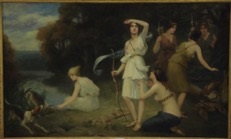Fernand Le Quesne (French, 1856–1932)
Diana and Her Hunting Maidens
Oil on canvas, 40 x 65 3/4 in.
Signed lower right: F. Le Quesne
1996.4

In Diana and Her Hunting Maidens, Le Quesne presents what could almost be described as a genre scene of hunting with classical figures. The goddess of the hunt, Diana (identified by her bow and the crescent moon on her forehead), stands prominently at the center of the composition, attended by her maidens, who kneel before Diana to hand her a golden arrow, mind the leashed hunting dogs, and inspect the goddess’s recent kill, their spears still in hand. Unlike most artists from the late 19th and early 20th century, Le Quesne depicts Diana as the goddess of the hunt, rather than the nude immortal caught off-guard at her bath by the young hunter Actaeon. According to Ovid’s Metamorphoses, Actaeon happens upon Diana while she is at her bath with her nymphs. Diana, startled and enraged by the young hunter’s appearance, turns Actaeon into a deer, and he in turn becomes hunted prey. The theme of Diana’s Bath became an increasingly popular subject for artists (for example, Jules Joseph Lefebvre’s Diana, Luc-Olivier Merson’s Diana, and René Menard’s The Bath of Diana, all in the Dahesh Museum of Art collection), because of the opportunity to depict the female nude as a respectable classical subject. Le Quesne’s Diana, however, is fully clothed, and his scene avoids any overt reference to the Actaeon story, thus departing from the 19th-century vogue for Bathing Dianas. Le Quesne created at least one other, slightly smaller version of his Diana and Her Hunting Maidens (private collection).


